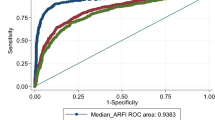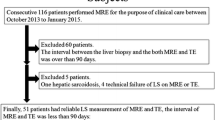Abstract
Background
Accurate evaluation of liver fibrosis in patients with chronic liver damage is required to determine the appropriate treatment. Various approaches, including laboratory tests and transient elastography, have been used to evaluate liver fibrosis. Recently, transient elastography with acoustic radiation force impulse (ARFI) has been developed and applied with conventional ultrasonography. The aim of this study was to evaluate the clinical utility of transient elastography with ARFI and to compare the results with this method and those of the Fibroscan® procedure.
Methods
One hundred and thirty-one patients with liver damage, who underwent liver biopsy at our department, were enrolled prospectively in this study. Elastography with ARFI (applied with ACUSON S2000®), and Fibroscan® was performed at the same time as liver biopsy. These measurements were compared with histological findings in liver biopsy specimens, and measurement accuracy was evaluated by receiver-operating characteristic analysis.
Results
Elastography values with both procedures were significantly correlated with the stages of liver fibrosis and there was little difference in the results obtained using the 2 procedures. The accuracy of differential diagnosis between no fibrosis at F0 and more than F1 stage was insufficient with ARFI, but this procedure was sufficient for diagnosing advanced fibrosis. The accuracy of ARFI was almost equivalent to that of the Fibroscan® method. Moreover, both ARFI and Fibroscan® values increased in proportion to the severity of hepatic inflammation when fibrosis stage is low, but not in proportion to the severity of steatosis.
Conclusions
Transient elastography with ARFI is simple, non-invasive and useful for diagnosing the stage of fibrosis in chronic liver disease. The utility of ARFI was almost equivalent to that of the Fibroscan® method.






Similar content being viewed by others
Abbreviations
- ARFI:
-
Acoustic radiation force impulse
- HCC:
-
Hepatocellular carcinoma
- US:
-
Ultrasonography
- ROI:
-
Region of interest
- ROC:
-
Receiver operating characteristic
- AUROC:
-
Area under ROC curve
References
Manning DS, Afdhal NH. Diagnosis and quantitation of fibrosis. Gastroenterology. 2008;134:1670–81.
Sherlock S. Aspiration liver biopsy, technique and diagnostic application. Lancet. 1945;ii:397.
Regev A, Berho M, Jeffers LJ, Milikowski C, Molina EG, Pyrsopoulos NT, et al. Sampling error and intraobserver variation in liver biopsy in patients with chronic HCV infection. Am J Gastroenterol. 2002;97:2614–8.
Bedossa P, Dargere D, Paradis V. Sampling variability of liver fibrosis in chronic hepatitis C. Hepatology. 2003;38:1449–57.
Dienstag JL. The role of liver biopsy in chronic hepatitis C. Hepatology. 2002;36:S152–60.
Poniachik J, Bernstein DE, Reddy KR, Jeffers LJ, Coelho-Little ME, Civantos F, et al. The role of laparoscopy in the diagnosis of cirrhosis. Gastrointest Endosc. 1996;43:568–71.
Sandrin L, Fourquet B, Hasquenoph JM, Yon S, Fournier C, Mal F, et al. Transient elastography: a new noninvasive method for assessment of hepatic fibrosis. Ultrasound Med Biol. 2003;29:1705–13.
Saito H, Tada S, Nakamoto N, Kitamura K, Horikawa H, Kurita S, et al. Efficacy of non-invasive elastometry on staging of hepatic fibrosis. Hepatol Res. 2004;29:97–103.
Fahey BJ, Nightingale KR, Nelson RC, Palmeri ML, Trahey GE. Acoustic radiation force impulse imaging of the abdomen: demonstration of feasibility and utility. Ultrasound Med Biol. 2005;31:1185–98.
Palmeri ML, Wang MH, Dahl JJ, Frinkley KD, Nightingale KR. Quantifying hepatic shear modulus in vivo using acoustic radiation force. Ultrasound Med Biol. 2008;34:546–58.
Lupsor M, Badea R, Stefanescu H, Sparchez Z, Branda H, Serban A, et al. Performance of a new elastographic method (ARFI technology) compared to unidimensional transient elastography in the noninvasive assessment of chronic hepatitis C. Preliminary results. J Gastrointestin Liver Dis. 2009;18:303–10.
The French METAVIR Cooperative Study Group. Intraobserver and interobserver variations in liver biopsy interpretation in patients with chronic hepatitis C. Hepatology. 1994;20:15–20.
Brunt EM. Nonalcoholic steatohepatitis: definition and pathology. Semin Liver Dis. 2001;21:3–16.
Sagir A, Erhardt A, Schmitt M, Häussinger D. Transient elastography is unreliable for detection of cirrhosis in patients with acute liver damage. Hepatology. 2008;47:592–5.
Arena U, Vizzutti F, Corti G, Ambu S, Stasi C, Bresci S, et al. Acute viral hepatitis increases liver stiffness values measured by transient elastography. Hepatology. 2008;47:380–4.
Nightingale RK, Soo MS, Nightingale R, Trahey G. Acoustic radiation force impulse imaging: in vivo demonstration of clinical feasibility. Ultrasound Med Biol. 2002;28:227–35.
Palmeri ML, Frinkley KD, Zhai L, Gottfried M, Bentley RC, Ludwig K. Acoustic radiation force impulse (ARFI) imaging of the gastrointestinal tract. Ultrason Imaging. 2005;27:75–88.
Sarvazyan AP, Rudenko OV, Swanson SD, Fowlkes JB, Emelianov SY. Shear wave elasticity imaging: a new ultrasonic technology of medical diagnostics. Ultrasound Med Biol. 1998;24:1419–35.
Wai CT, Greenson JK, Fontana RJ, Kalbfleisch JD, Marrero JA, Conjeevaram HS, et al. A simple noninvasive index can predict both significant fibrosis and cirrhosis in patients with chronic hepatitis C. Hepatology. 2003;38:518–26.
Imbert-Bismut F, Ratziu V, Pieroni L, Charlotte F, Benhamou Y, Poynard T, et al. Biochemical markers of liver fibrosis in patients with hepatitis C virus infection: a prospective study. Lancet. 2001;357:1069–75.
Talwalkar JA, Kurtz DM, Schoenleber SJ, West CP, Montori VM. Ultrasound-based transient elastography for the detection of hepatic fibrosis: systematic review and meta-analysis. Clin Gastroenterol Hepatol. 2007;5:1214–20.
Friedrich-Rust M, Ong MF, Martens S, Sarrazin C, Bojunga J, Zeuzem S, et al. Performance of transient elastography for the staging of liver fibrosis: a meta-analysis. Gastroenterology. 2008;134:960–74.
Foucher J, Chanteloup E, Vergniol J, Caste′ra L, Le Bail B, Adhoute X et al. Diagnosis of cirrhosis by transient elastography (FibroScan): a prospective study. Gut. 2006;55:403–8.
Kim KM, Choi W-B, Park SH, Yu E, Lee SG, Lim Y-S, et al. Diagnosis of hepatic steatosis and fibrosis by transient elastography in asymptomatic healthy individuals: a prospective study of living related potential liver donors. J Gastroenterol. 2007;42:382–8.
Iijima H. The usefulness of non-invasive diagnosis of liver fibrosis using acoustic radiation force impulse. Kanzo. 2010;51:54–5.
Obara N, Ueno Y, Fukushima K, Nakagome Y, Kakazu E, Kimura O, et al. Transient elastography for measurement of liver stiffness measurement can detect early significant hepatic fibrosis in Japanese patients with viral and nonviral liver diseases. J Gastroenterol. 2008;43:720–8.
Masuzaki R, Tateishi R, Yoshida H, Goto E, Sato T, Ohki T, et al. Prospective risk assessment for hepatocellular carcinoma development in patients with chronic hepatitis C by transient elastography. Hepatology. 2009;49:1954–61.
Kettaneh A, Marcellin P, Douvin C, Poupon R, Ziol M, Beaugrand M, et al. Features associated with success rate and performance of FibroScan measurements for the diagnosis of cirrhosis in HCV patients: a prospective study of 935 patients. J Hepatol. 2007;46:628–34.
Author information
Authors and Affiliations
Corresponding author
Rights and permissions
About this article
Cite this article
Ebinuma, H., Saito, H., Komuta, M. et al. Evaluation of liver fibrosis by transient elastography using acoustic radiation force impulse: comparison with Fibroscan® . J Gastroenterol 46, 1238–1248 (2011). https://doi.org/10.1007/s00535-011-0437-3
Received:
Accepted:
Published:
Issue Date:
DOI: https://doi.org/10.1007/s00535-011-0437-3




